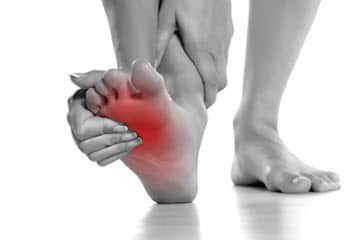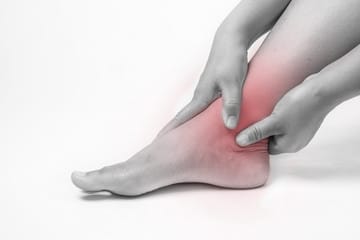
Treatment for Foot & Ankle Pain in Manhattan: Comprehensive Pain Relief and Recovery
At Gramercy Physical Therapy, our team is dedicated to providing top-tier foot and ankle care for patients of all ages throughout Manhattan and New York City. We pride ourselves on offering comprehensive treatments designed to alleviate pain, restore mobility, and ensure long-term recovery. Our experienced team collaborates closely with each patient to develop personalized treatment plans that promote quick recovery and minimize downtime.
Treatment for Foot & Ankle Problems
We specialize in treating a variety of foot and ankle issues, including chronic conditions and acute injuries. Whether you’re dealing with ankle pain from a sprain, strain, or other causes, our goal is to deliver tailored care that promotes healing and strengthens your mobility.
For patients experiencing inside ankle pain, lateral ankle pain, or discomfort along the top of the ankle or foot, we utilize a range of advanced techniques, including:
- Soft tissue mobilization: Reduces tension in the muscles and ligaments to promote flexibility and healing.
- Ultrasound therapy: A non-invasive method that uses sound waves to stimulate tissue repair.
- Iontophoresis: Delivers medication directly to the injured area using electrical currents.
- Electrical stimulation (ESTM/TENS): Helps relieve pain and encourage muscle contraction to improve circulation.
- Neural stretching: Targets nerve-related issues to reduce pain and improve range of motion.
- Spinal mobilization: Helps alleviate pressure on nerves that could be contributing to ankle pain.
- Active Release Technique® (ART): Breaks down scar tissue and adhesions to improve joint mobility.
- Strength exercises: Strengthens the muscles around the foot and ankle for enhanced stability.
- Stability exercises: Improves ankle control and stability with functional and athletic mobility.
- Heat therapy: Eases stiffness and promotes blood flow to aid recovery.
- Manual traction therapy: Reduces pressure on joints to relieve pain and enhance movement.
- Postural reeducation and strengthening therapy: Focuses on correcting posture imbalances that could contribute to chronic foot and ankle pain.
Our Manual PT approach integrates physical therapy for ankle pain with techniques to provide an individualized, effective solution for patients seeking relief from foot and ankle pain.
Common Foot & Ankle Injuries
Our team at Gramercy Physical Therapy treats a wide range of conditions related to the ankle and foot. Whether you’re dealing with inner ankle pain or discomfort from a stress fracture, we are here to help you regain full function. By combining sports medicine best practices with the latest advancements in physical therapy, we address issues like:
- Achilles Tendonitis: Inflammation of the Achilles tendon, often due to overuse or strain.
- Ankle Instability: A condition where the ankle is prone to repeated sprains, leading to chronic pain and weakness.
- Ankle Sprain/Strain: Damage to the ligaments (sprain) or muscles (strain) of the ankle.
- Arthritis and Osteoarthritis: Inflammation in the ankle joint, causing pain and limited mobility.
- Bone Spurs and Heel Spurs: Abnormal bone growth that can cause significant discomfort and pain.
- Post Operative: Reconstructive, esthetic and post traumatic surgeries.
- Plantar Fasciitis: Inflammation of the plantar fascia, a thick band of tissue connecting the heel to the toes, causing heel pain.
- Retrocalcaneal Bursitis: Inflammation of the bursa located near the Achilles tendon.
- Shin Splints: Pain along the shin bone due to overuse or repetitive stress.
- Stress Fracture: Tiny cracks in the bone, often caused by repetitive stress or overuse.
- Tarsal Tunnel Syndrome: Compression of the tibial nerve as it travels through the tarsal tunnel, causing pain in the ankle and foot.
AFO Braces for Foot Drop
For patients dealing with foot drop, a condition that makes it difficult to lift the front part of the foot, we offer AFO (Ankle-Foot Orthosis) braces. These braces provide support and stability, allowing patients to regain normal movement patterns while preventing further injury. Our team will work closely with you to determine the best brace for your needs, ensuring that it fits comfortably and offers the right level of support.
Specialized Care for Ankle and Foot Pain
At Gramercy Physical Therapy, we focus on providing targeted therapy for ankle pain that addresses the root cause of the discomfort. Whether your pain originates from the top of the ankle, the medial (inside) or lateral (outside) ankle, or even radiates from the foot, our team will work to improve your mobility and reduce pain. Using a combination of cutting-edge physical therapy and rehabilitation techniques, we help you return to normal activities with confidence.
Whether you’re recovering from a sports injury, dealing with chronic pain, or experiencing mobility issues, our expert team is here to help. Contact us today to schedule your consultation and start your journey to recovery.
Our focus on individualized care, combined with the latest treatment modalities, makes us one of the top choices for ankle pain treatment in Manhattan and New York City. Let Gramercy Physical Therapy provide the support and expertise you need for effective, lasting relief from foot and ankle pain.
Frequently Asked Questions
1. What are the common causes of ankle and foot pain?
Ankle and foot pain can result from various factors, including injuries like sprains, strains, or fractures, overuse from sports or physical activities, arthritis, plantar fasciitis, and conditions like Achilles tendonitis or gout. Improper footwear, poor posture, and muscle imbalances can also contribute to pain.
2. How can physical therapy help relieve ankle pain?
Physical therapy helps alleviate ankle pain by improving flexibility, strengthening muscles, and addressing underlying biomechanical issues. Treatments like soft tissue mobilization, stretching, and electrical stimulation can reduce pain and inflammation while promoting long-term recovery and improved function.
3. How do I know if I need a brace for my foot or ankle?
If you’re experiencing instability, weakness, or difficulty walking due to an injury or chronic condition, an ankle or foot brace may provide necessary support. Our therapists will assess your condition and recommend the best brace for your needs, including AFO braces for foot drop.
4. What is plantar fasciitis, and how is it treated?
Plantar fasciitis is inflammation of the thick tissue along the bottom of your foot that connects your heel to your toes, often causing severe heel pain. Treatment includes stretching exercises, soft tissue mobilization, ultrasound therapy, and the use of orthotics or supportive footwear to relieve pain.
5. How long does it take to recover from an ankle sprain or injury?
Recovery time for an ankle sprain or injury varies based on its severity. Mild sprains may heal within 2 to 4 weeks with rest and physical therapy. More severe injuries could take several months to fully recover, especially if rehabilitation is needed to restore strength and stability.
6. What should I do if I have chronic ankle or foot pain?
If you experience chronic ankle or foot pain, it’s important to seek professional evaluation. Prolonged pain may indicate an underlying issue like arthritis or tendonitis. Our team will assess your condition and develop a customized treatment plan that includes physical therapy, stretching, and strengthening exercises to relieve pain.
7. Can I prevent foot and ankle injuries?
While not all injuries can be prevented, you can reduce your risk by wearing proper footwear, maintaining a healthy weight, and engaging in regular stretching and strengthening exercises. Avoid overuse by resting when necessary and using appropriate support for physical activities.
These FAQs will help educate your audience on common concerns while showcasing your expertise in treating foot and ankle conditions.
Education
- Invest in proper footwear, particularly for sports participation
- Women should limit time spent in high heels or flat shoes lacking arch support
- Runners should replace sneakers frequently, approximately every 350-500 miles
- A healthy weight will reduce undue pressure on your ankles, heels, and feet



